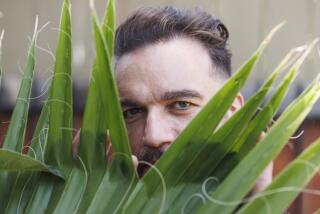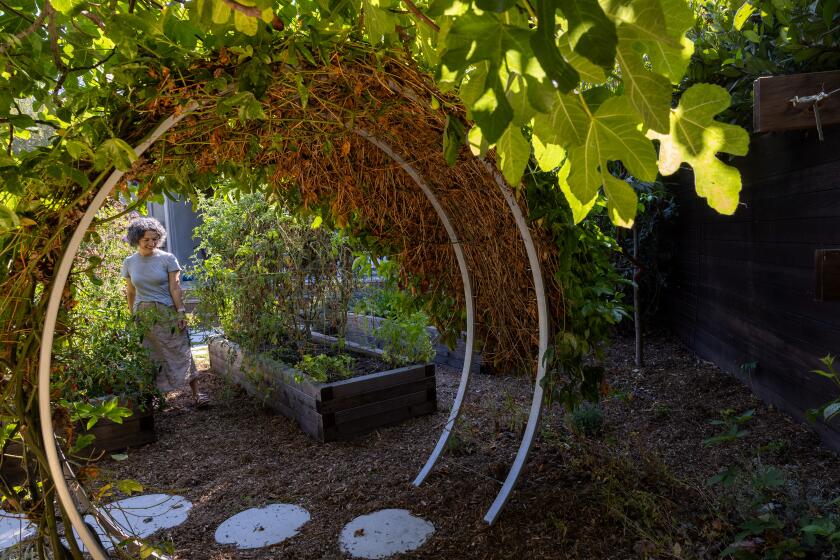Perry Mason’s Other Role: Orchid Champion
You could have sworn it was Perry Mason himself--that huge, glowering figure who was firing such enigmatic questions as “What’s the temperature in here?” and “How did the roof blow off?”
But it was actor Raymond Burr appearing in a different role--this time as the orchid hybridizer caught up in the case of the inadequate greenhouses.
Burr, who plays the fictional criminal lawyer in the famed television series, made one of his frequent visits Monday to Cal Poly Pomona.
Instead of a film crew, he was attended by faculty, students and a few old friends who share his interest in the highly prized orchid collection that he gave to the university in 1982 and has been adding to ever since.
Developed 3,000 Species
Actor, rancher, orchid breeder, law school graduate and philanthropist, Burr said he had more orchids than he could care for in the early 1980s. So he sought a permanent home for several thousand of them, including about 3,000 species he had developed.
He chose Cal Poly because of his friendship with the university’s president, Hugh O. La Bounty, Burr said. He returns once or twice a year to make sure he made the right decision and to see how many more plants the greenhouses can accommodate.
“He’s ready now to ship us more, but we’re not ready for them,” said Frank Gibbons, chairman of the ornamental horticulture department. “We have four greenhouses that are crowded with orchids, and one we’re building that will be full as soon as it’s finished. Space is a problem.”
‘Good for the School’
Burr’s explanations for his gifts shoot down a couple of legends that have grown along with the collection. Several people, including La Bounty, said they believe the actor’s interest was piqued several years ago when he was a television announcer for the Tournament of Roses and learned that Cal Poly students raised their own flowers to decorate the floats that they designed.
“I didn’t donate orchids so they would end up on a float,” Burr said with an undramatic shrug. “I thought (the collection) would be good for the school.”
Some school officials said they believe Burr had to give up his collection when he moved from Southern California to a ranch near Santa Rosa north of San Francisco. But, he explained, “it is a full-time, 24-hours-a-day job and I had to do other things.”
The 71-year-old actor walks slowly with a cane but is still performing as Perry Mason. He also is still experimenting with orchids and shipping hundreds of plants to Cal Poly every year.
“In my judgment, the orchid collection makes us unique in the country,” La Bounty said. “Our students can learn techniques of propagating and hybridizing that we wouldn’t have if it weren’t for Raymond Burr.”
“It’s unusual and outstanding,” Gibbons said. “We want to see this be a center for research and hybridizing and become as well known as Cal Poly’s Arabian Horse Center.”
Gibbons said students learn orchid propagation and hybridizing--a technique of cross-pollination to create new shapes and colors--and some earn money by raising and selling the plants through Cal Poly’s student nursery.
“People want Raymond Burr orchids,” Gibbons said.
Don Delano, the teacher in charge of the orchid collection, estimates the total value of Burr’s gifts through the years exceeds $100,000.
In the first couple of years, Delano said, Burr gave the school thousands of plants, two greenhouses and greenhouse equipment.
In ensuing years, he has given thousands more plants, ranging in value from $6 to $1,000, and the school has had grant money to acquire five greenhouses. The newest, which is not yet completed, will be filled almost immediately because of overcrowding elsewhere, Delano said.
Meanwhile, the sale of orchids, ranging from tiny seedlings to mature, blossoming plants, helps pay for the power and water the plants require. Orchids need steady, warm temperatures and a staff to take care of them.
Delano said there is no way to estimate the number of individual plants in the Burr collection because it is constantly changing. While students and faculty experiment with thousands of seedlings, which take six or seven years to bloom, other means of propagation are being tried.
The collection was reduced slightly last winter when storms ripped off portions of two greenhouse roofs and damaged several plants.
Burr examined everything.
Asked if he made the right decision in giving Cal Poly his collection, he nodded solemnly and said: “I think so. It was only hard to decide because the school wasn’t prepared to take it. They’ve had to work very hard to make areas to house the orchids, and they’ve managed miraculously.”
Burr said he saw nothing incompatible between his major interests--acting and horticulture.
Growing things, he said, can be more creatively satisfying than acting. “The more things you pay attention to in your life, the easier it is to draw on those things in your acting.
“You learn over the years that the flora and fauna in the world can be communicated with in one way or another, and they respond. Sometimes you can’t communicate to your audience. A bad script will stop that.”
He started growing orchids as a 12-year-old, he said, and has never stopped.
“I’m glad I chose acting over any other profession,” Burr said. “I’ve done a hell of a lot more for the human race being an actor. I don’t know any doctors or lawyers or ministers who would give (away) an orchid collection.”
La Bounty said Burr gives more than orchids and greenhouses. He gave an “inspired and inspiring” commencement talk several years ago and is an active member of the President’s Council, a support group for Cal Poly.
This week, La Bounty announced that Burr is co-chairman with Keith Kellogg, grandson of the founder of Cal Poly, of Partners in Progress, a multimillion-dollar fund-raising program connected with the 50th anniversary of the university next year.
“I think it’s very unusual for an actor to take such a role, and I’m very glad that unusualness is at Cal Poly Pomona,” La Bounty said.






